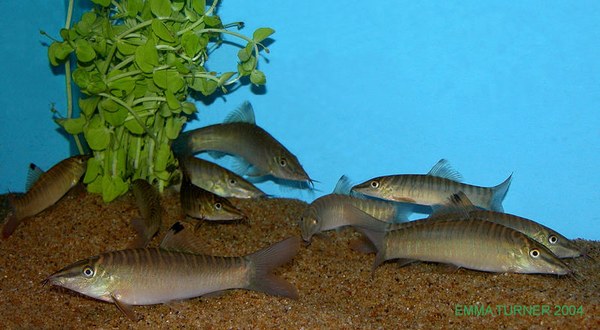Syncrossus hymenophysa
Summary
< Back to "Telling Tigers Apart"
Scientific name: Syncrossus hymenophysa (Bleeker, 1852)
Common name: Tiger loach, Tiger
Botia, Green Tiger Loach.
Synonyms: Botia hymenophysa, Cobitis hymenophysa
(Bleeker, 1852)
Distribution:
Borneo & Sumatra, Indonesia, peninsular Malaysia.
Sexual Dimorphism: Mature females likely to
have a rounder abdomen.
Maximum
size: 25cm (10").
Similar to: Syncrossus helodes.

Care: Keep in a large sized aquarium, ideally
measuring at least 4ft long to start with, and be prepared to move the fish on
to bigger quarters as they grow. The substrate must be fine and sandy in order
to protect the delicate sensory barbel area. Provide plenty of hiding places in
the aquarium amongst bogwood, caves, and plants. Clean, well-aerated
water is a must.
Feeding: Will
accept most brands of dry sinking catfish pellets, but should be offered a
variety of frozen foods to supplement the diet - mosquito larvae and brineshrimp
are usually taken with much enthusiasm. Larger specimens will take mysis shrimp,
krill and chopped prawns.
Water
parameters: Soft and slightly acidic is best. pH: 7.0 or below, dH:
<12 degrees.
Temperature: 77ºF
to 86ºF (25-30°C)
Breeding: Not known to have been bred in aquaria.
Notes
 A large member of the Tiger Botia group, which like it's close relatives, is of
an aggressive nature and not suitable for community aquariums. This species,
like other Syncrossus, must be
maintained in groups of 5 or more in order to spread any aggression and to allow
the fish to form a natural hierarchy.
A large member of the Tiger Botia group, which like it's close relatives, is of
an aggressive nature and not suitable for community aquariums. This species,
like other Syncrossus, must be
maintained in groups of 5 or more in order to spread any aggression and to allow
the fish to form a natural hierarchy.
Tankmates must be robust and fast-swimming, for example, some of the more gregarious medium-large sized members of the barb or Danio families. Can be kept with other aggressive loach species such as Syncrossus helodes, Syncrossus berdmorei, Yasuhikotakia morleti etc.
Sometimes confused with S. helodes. They can be easily told apart by the direction of the stripes anterior to the dorsal fin. In S. hymenophysa, the stripes are orientated so that they start at the dorsal surface with the bottom of the stripes finishing further forwards towards the front of the fish. In S. helodes, it is the other way around, with the stripes leaning backwards instead of forwards. S. helodes also has a series of mixed size, dark oval spots which are vertically orientated in the area between the pectoral fin and anus. S.helodes also lacks the dorsal spot found in S. hymenophysa.
For more information see: Telling Tigers Apart - The Syncrossus Group of Loaches
Photo Gallery
Click to view all images of this species! |
|
Document Actions


